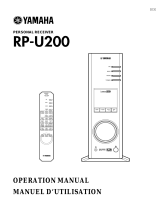
Selecting the sound mode..................................................................... 49
Enjoying stereoscopic sound fields (CINEMA DSP 3D)............................................................................................ 50
Enjoying unprocessed playback...................................................................................................................................... 52
Enjoying pure high fidelity sound (direct playback)................................................................................................. 53
Enhancing the bass (Extra Bass)....................................................................................................................................... 53
Playing back digitally compressed formats (such as MP3, etc.) with enriched sound (Compressed
Music Enhancer)
..................................................................................................................................................................... 53
Listening to FM/AM radio
....................................................................... 54
Setting the frequency steps............................................................................................................................................... 54
Selecting a frequency for reception............................................................................................................................... 54
Registering favorite radio stations (presets)................................................................................................................ 55
Radio Data System tuning.................................................................................................................................................. 58
Playing back music stored on a Bluetooth® device.............................. 59
Playback Bluetooth® device music on the unit........................................................................................................... 59
Enjoying audio using Bluetooth® speakers/headphones....................................................................................... 60
Playing back music with AirPlay............................................................ 61
Playback of iTunes/iPod music contents...................................................................................................................... 61
Playing back music stored on a USB storage device............................ 63
Connecting a USB storage device................................................................................................................................... 63
Playback of USB storage device contents..................................................................................................................... 63
Playing back music stored on media servers (PCs/NAS)...................... 66
Media sharing setup............................................................................................................................................................. 66
Playback of PC music contents......................................................................................................................................... 67
Listening to Internet radio..................................................................... 69
Playback of Internet radio.................................................................................................................................................. 69
Registering favorite Internet radio stations (bookmarks)....................................................................................... 71
Playing back more high-quality sounds with bi-amp connections
.................................................................................................................. 72
Connecting front speakers that support bi-amp connections............................................................................. 72
Playing back music in multiple rooms.................................................. 73
Connecting Zone B speakers............................................................................................................................................. 73
Operating the Zone B........................................................................................................................................................... 74
Useful functions...................................................................................... 76
Registering favorite items (shortcut).............................................................................................................................. 76
Configuring playback settings for different playback sources
(Option menu)......................................................................................... 78
Option menu items............................................................................................................................................................... 78
CONFIGURATIONS 82
Configuring various functions (Setup Menu)....................................... 82
Setup menu items................................................................................................................................................................. 83
Speaker...................................................................................................................................................................................... 85
HDMI........................................................................................................................................................................................... 90
Sound......................................................................................................................................................................................... 92
ECO............................................................................................................................................................................................. 95
Function.................................................................................................................................................................................... 96
Network..................................................................................................................................................................................... 99
Bluetooth............................................................................................................................................................................... 101
Language............................................................................................................................................................................... 102
Configuring the system settings (ADVANCED SETUP menu)............ 103
ADVANCED SETUP menu items..................................................................................................................................... 103
Changing the speaker impedance setting (SP IMP.).............................................................................................. 103
Selecting the remote control ID (REMOTE ID).......................................................................................................... 104
Changing the FM/AM tuning frequency setting (TU)............................................................................................ 104
Switching the video signal type (TV FORMAT)......................................................................................................... 104
Selecting the HDMI 4K signal format (4K MODE).................................................................................................... 104
Restoring the default settings (INIT)............................................................................................................................. 105
Updating the firmware (UPDATE)................................................................................................................................. 105
Checking the firmware version (VERSION)................................................................................................................. 105
Updating the unit’s firmware via the network................................... 106
APPENDIX 107
Frequently asked questions................................................................ 107
En
3




















